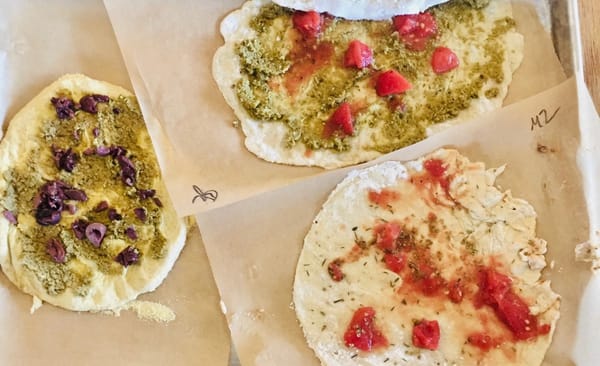Recipe: Gluten-Free Sourdough Flatbread
New to sourdough? Here's a gluten-free sourdough flatbread recipe complete with starter instructions.

New to sourdough? Here's a gluten-free sourdough flatbread recipe complete with starter instructions.

Photo courtesy Evelyn Battaglia
The following flatbread and starter recipes were provided by Rachel Portnoy, former chef of Chez Nous/Cafe Triskele and baking instructor at Canyon Ranch — and a judge at Dewey Hall's sourdough bread contest on March 4. The flatbread recipe calls for active yeast in addition to the starter because the goal is to be able to make something relatively quickly and, unlike with a rustic sourdough loaf, you aren't looking for the same taste and texture that can only be achieved through the long, slow fermentation process.
1 cup (320g) gluten-free sourdough starter (see below)
2 cups (256g) gluten-free flour blend
2 tablespoons (14g) flax meal
1 1/2 teaspoons (6g) sugar
1 1/2 teaspoons (9g) kosher salt
1/2 teaspoon (2g) active dry yeast
1/2 cup (120g) water
3 tablespoons (40g) olive oil, plus more for brushing
1 large egg
Assorted toppings, such as tomato sauce, fresh tomatoes, pitted olives, tapenade, seeds, dried herbs, and/or spices
1. Place the sourdough starter in the bowl of a stand mixer. In another bowl, whisk the flour blend, flax meal, sugar, salt, and yeast. Add the dry ingredients to the starter and mix on low speed until combined. Stir in the water, olive oil, and egg, then beat on high speed for 2 to 3 minutes or until thick. Let the dough rest for 1 to 1 1/2 hours.
2. Preheat the oven to 500°F. Line three baking sheets with parchment and brush with oil. Stir the dough and portion onto the baking sheets in 4- to 5-inch ovals. Top as desired and bake for 5 minutes or until crisp.
Gluten-Free Sourdough Starter
The starter takes six days to activate but it will keep going for as long as you keep feeding it.
Buckwheat flour or brown rice flour
Sweet white rice flour
Water
Day one: In a medium glass bowl or jar, whisk together 2 tablespoons (20g) buckwheat or brown rice flour, 2 tablespoons (20 grams) sweet rice flour, and 1/4 cup (60g) water. Cover with a damp tea towel and rest at room temperature for 24 hours.
Day two: In another medium glass bowl or jar, whisk 2 tablespoons (40g) of the mixture from day one (discard the leftovers) with 2 tablespoons (20g) buckwheat or brown rice flour, 2 tablespoons (20g) sweet rice flour, and 1/4 cup (60g) water until combined. Cover with a damp towel or loose-fitting lid and rest at room temperature for 24 hours.
Day three through day six or seven: Repeat the process from day two using the previous day’s starter until the mixture becomes puffy, has a pleasant sweet-sour aroma, and bubbles being or air pockets are visible under the surface, six to seven days. Your starter is now ready for use or storing in the refrigerator, covered.
The starter must be refreshed (or fed) at least every couple weeks:
Put 1/4 cup (80g) of the starter in a clean lidded jar (discard the leftovers, give it to a friend, or put it to use) and mix in 1/3 cup (80g) water. Add 3 tablespoons (30g) buckwheat or brown rice flour and 3 tablespoons (30g) sweet rice flour. Mix well until the flours are hydrated. Loosely lid the jar and wrap a rubber band around it at the height of the starter for a visual cue of how much the starter has grown over time.
Allow the starter to develop at room temperature for 8 to 12 hours or until it doubles in size before using.
After you measure out the amount needed for your recipe, refresh the starter in the same manner and store in the refrigerator. (Or just put the refreshed starter back in the refrigerator.)